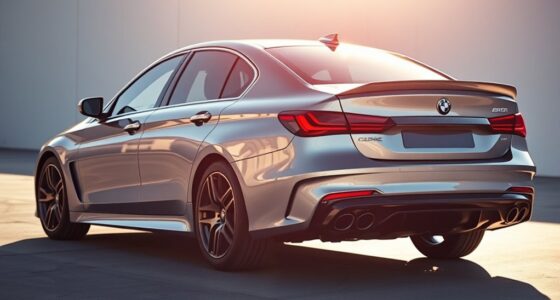Forget horsepower—what really makes a car feel quick is its torque-to-weight ratio. While high horsepower might sound impressive, it doesn’t tell you how fast a car accelerates or responds in real-world driving. Instead, focus on how much torque the car produces relative to its weight, which directly impacts its quickness and agility. To discover the true measuring stick of speed and responsiveness, keep going and uncover the details behind this critical metric.
Key Takeaways
- Vehicle weight significantly influences acceleration; lighter cars are quicker even with less horsepower.
- Torque, indicating engine twisting force, directly impacts responsiveness and launch performance.
- The torque-to-weight ratio provides a clearer measure of a car’s quickness than horsepower alone.
- A high torque-to-weight ratio means faster acceleration and more agility in real-world driving.
- Focusing on power efficiency and weight gives a more accurate sense of a vehicle’s responsiveness.

When it comes to making a car feel quick on the road, horsepower isn’t the whole story. Sure, a high horsepower figure might catch your eye, but it doesn’t tell the full story of how fast or responsive a vehicle actually is. What truly matters is how efficiently that power translates into acceleration, and that’s where vehicle weight and torque to weight ratio come into play. The lighter the car, the less mass it has to move, so even modest power can produce impressive acceleration. Conversely, a heavy car might boast high horsepower, but its weight drags down its responsiveness and quickness. It’s all about finding the right balance between power and mass.
Your vehicle’s torque to weight ratio is a critical indicator of how fast a car can accelerate. Torque measures the twisting force that the engine produces, and a higher torque allows for quicker launches and more immediate throttle response. When you compare that torque to the car’s weight, you get a clear picture of how effectively that force is used. A high torque to weight ratio means your car can accelerate rapidly because it doesn’t have to work as hard to get moving. Think of it as the engine’s strength relative to the vehicle’s mass. If your car weighs 3,000 pounds and produces 300 pound-feet of torque, your ratio is 0.1. If another car weighs 2,500 pounds with the same torque, its ratio improves to 0.12, making it feel quicker and more eager off the line.
A higher torque-to-weight ratio means quicker acceleration and more responsive driving.
This ratio is especially important when comparing cars within the same class or segment. Two vehicles might have similar horsepower numbers, but if one is considerably lighter or has better torque, that car will feel noticeably faster in real-world driving. It’s why sports cars designed with lightweight materials and optimized engines deliver more thrilling acceleration than their heavier counterparts with similar horsepower ratings. When you focus on the torque to weight ratio, you’re effectively evaluating how much “bang for your buck” you’re getting—how much acceleration you can squeeze out of each pound or kilogram of vehicle mass.
In essence, if you want a car that feels quick, don’t just look at horsepower. Pay attention to vehicle weight and how the engine’s torque measures up against that weight. A high torque to weight ratio ensures your car responds sharply and accelerates swiftly, making every drive more exciting. For a comprehensive understanding of vehicle performance, consider vehicle weight and how it interacts with power metrics to impact acceleration. It’s the real metric that gives you a true sense of a vehicle’s agility and speed potential, often more meaningful than raw horsepower figures alone.
Frequently Asked Questions
How Does Torque Influence a Car’s Acceleration?
Torque plays a key role in your car’s acceleration because it determines how much force the engine generates to turn the wheels. Higher torque means quicker starts and better engine braking control, especially when combined with good tire grip. When you accelerate, that torque pushes you forward more effectively, making your car feel faster. So, don’t just focus on horsepower—torque’s the real factor that influences how swiftly your car responds.
What Role Does Weight Play in Vehicle Speed?
You might think lighter vehicles always go faster, but it’s more nuanced. Vehicle weight considerably impacts acceleration and top speed because less weight means less resistance and easier handling. Weight reduction can boost performance, especially in racing or sporty driving. While power matters, reducing vehicle weight allows your car to accelerate quicker and handle better, making it feel faster and more agile—so don’t overlook the power of a lighter ride.
Is Horsepower Still Relevant in Modern Car Performance?
Horsepower remains relevant in modern car performance because it influences acceleration and top speed, but it’s not the only factor. You should also consider engine noise, which impacts driving comfort, and fuel efficiency, which affects long-term costs. While high horsepower can deliver quick starts, a well-balanced vehicle with good torque and lightweight design often offers better overall performance and efficiency. So, horsepower still matters, but it’s part of a bigger picture.
How Can Aerodynamics Improve Car Agility?
You can boost your car’s agility by optimizing aerodynamics to reduce aero drag and increase downforce effects. Better aerodynamics help your vehicle cut through the air more efficiently, allowing faster acceleration and sharper handling. Downforce effects press the car onto the road, improving grip during turns and high-speed maneuvers. By focusing on these aspects, you enhance your car’s responsiveness and cornering prowess, making it feel quicker and more agile on the road.
What Is the Impact of Drivetrain Layout on Quickness?
Drivetrain design directly dictates your car’s drive and dash. A layout optimized for drivetrain efficiency enhances traction control, allowing power to flow smoothly to the wheels. Front-engine, rear-wheel, or all-wheel drive each offers unique benefits, affecting quickness and handling. By choosing the right drivetrain layout, you improve your vehicle’s agility and acceleration, ensuring you get the most out of every move on the road or track.
Conclusion
So, next time you’re chasing that thrill, forget horsepower. There’s a hidden metric lurking beneath the numbers that truly determines a car’s speed. It’s not what everyone’s talking about, yet it could change everything you thought you knew. Are you ready to uncover the secret that could redefine your entire view of quick cars? Stay tuned—what you discover might just leave you questioning everything. The real key to speed is waiting to be revealed.










